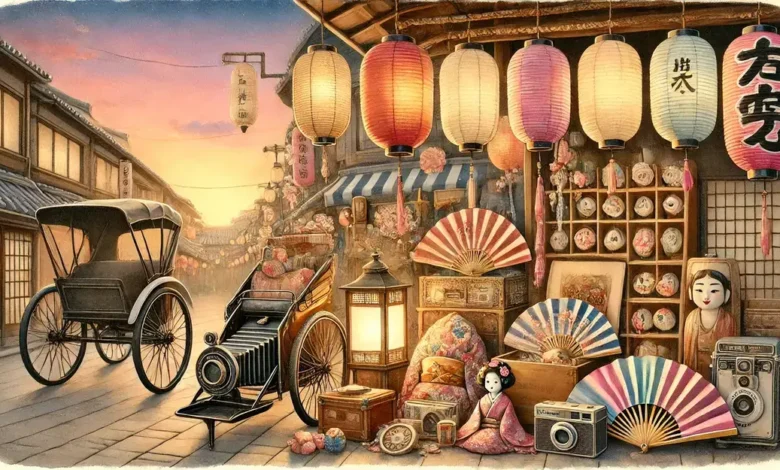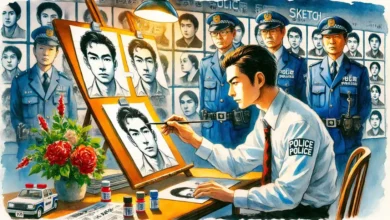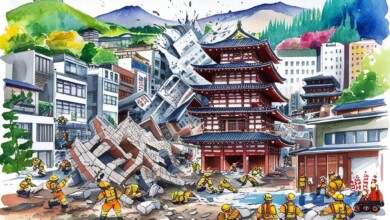Nostalgia Items in Japan: Actually Popular In The Past

Japan is a country that is known for its unique culture and rich history. While the country has embraced modern technology and innovation, there are still some things from the past that hold a special place in the hearts of the Japanese people. In this blog post, we will take a look at 14 nostalgia items in Japan that are still popular today.
1. The Fax Machine – A Relic of the Past
In Japan, the fax machine is a special item that brings back memories of the past, a device that gained fame in the 80s and 90s. Even though we live in a world full of emails and quick messages, many people in Japan still use fax machines. In fact, more than half of all Japanese homes have a fax machine. These tools are not old or outdated. Because companies continue to make new models with the latest technology, they are actually quite modern.
The fax machine, or “ファックス” as it’s called in Japanese, is not just used for sending notes. It can also work as a telephone. During the COVID-19 pandemic, when many people started working from home, fax machines were still widely used in Japan. So, the fax machine is not just a piece of history in Japan. It’s a useful tool that is still part of everyday life.

A Survey Reveals 34% of Japanese Households Own a Fax Machine
In 2020, the Japanese government did a survey. They found out that 34% of homes in Japan have a fax machine. Most of the people using them are older. They like to write by hand instead of typing. That’s why fax machines are still used in Japan. It’s easier for them to use. So, even though we have new technology, old things like fax machines are still important in some places. Isn’t that interesting?
NHK Asks Spectators to Send Messages via Fax during the 2021 Tokyo Olympics
Even during the 2021 Tokyo Olympics, national broadcaster NHK asked spectators to send messages of support to its athletes via fax, indicating Japan’s continued affinity for the device.
2. Cash is Still King in Japan
In Japan, cash is still the most popular way to pay for things. Even though we have credit cards and digital payments, many people in Japan prefer to use cash. In fact, more than 90 percent of people in Japan said cash was their most-used payment method. This is even though some people said they used less cash during the COVID-19 pandemic.
Cash is not just a way to pay for things in Japan. It’s also a part of the culture. People treat cash with great respect. For example, some people think that keeping your cash neat and uncreased in a wallet can help you appreciate your money and control your spending.

Cashless Payments Only Make Up 32% of Transactions in Japan
Here’s a fun fact. In Japan, most people still use cash to pay for things. Only 32% of payments are made without cash. In South Korea, it’s different. There, 93% of payments are cashless. The Japanese government is trying to change this. They want more people to pay without cash. But many stores in Japan still only take cash. Even in big cities like Tokyo, many small businesses prefer cash. So, if you ever visit Japan, don’t forget to bring some cash!
3. Physical CDs – A Cherished Relic of the Music Industry
In Japan, physical CDs are a cherished part of the music industry. Even though many countries have moved to digital music, Japan still loves CDs. In fact, in 2019, 70 percent of music sales in Japan were CDs. This might seem surprising, but there’s a reason for it.
CDs are not just about the music in Japan. They’re also about the experience. When you buy a CD, you get more than just songs. You might get posters of your favorite music idols or even tickets to concerts. This makes buying CDs exciting and special.
Even as the world changes, Japan continues to value CDs. This shows how Japan combines the old with the new. It’s a part of Japanese culture that makes it unique and interesting.

CD Sales Expected to Surpass Digital Sales by 2022
The COVID-19 pandemic changed many things, including music in Japan. More people started listening to music online. But CDs are still very important there. People in Japan still buy a lot of CDs. In fact, by 2022, people might buy more CDs than digital music.
So, even though we have new ways to listen to music, CDs are still popular in Japan. It’s another interesting thing about Japanese culture. It shows how they value both old and new things.
4. Business Cards – A Representation of Identity in Japan
In Japan, business cards, known as “meishi”, are a big deal. They are not just pieces of paper with contact information. They are a representation of a person’s identity. When you meet someone for the first time in a business setting, you will likely exchange business cards.
The details on the business card include your name, position, company name, company address, telephone number, and email. If your business is multinational, one side of the card is printed in Japanese and another in English.
Exchanging business cards in Japan is a careful process with set guidelines. You should stand up, face the other person, and present your business card with both hands. The other person should be able to read it without rotating or turning it. After receiving a business card, take a moment to inspect it. This shows respect for the other person and their business.

Artistic Designs of Japanese Business Cards
In Japan, business cards are special. They often have beautiful patterns and fancy writing. This shows the company’s style and the person’s identity. The cards are made with good paper and careful detail. This makes each card a unique piece of art. So, in Japan, a business card is more than just a card. It’s a way to show who you are and what your company is about. It’s another cool thing about Japanese culture.
5. Font Art – A Beautiful Expression of the Japanese Language
In Japan, font art is a beautiful way to express the Japanese language. It’s not just about writing words. It’s about creating art with letters. There are many different types of Japanese fonts. Some look like classic brush-style calligraphy, while others are modern typefaces. Each font has its own unique style and flavor.
When you see a Japanese font, you’re seeing a piece of Japanese culture. Each font tells a little story about Japan. For example, some fonts are inspired by traditional Japanese architecture. Others are inspired by Asian cuisine. This makes each font special and unique.

A Brief History of Japanese Font Art
Japanese Font Art, or Moji Art, has a long history. It was very popular during a time called the Edo period. At first, people used it to make temples and shrines look nice. But over time, it changed. Now, it’s an art form that everyone can enjoy every day.
Techniques Used in Japanese Font Art
Artists pick characters and arrange them to make a design. Then, they use different ways of painting to make it look good. Because they pay close attention and know Japanese well, their art is amazing.
6. Website Design – A Busy and Colorful Representation of Japan
Unlike many Western websites that are simple and clean, Japanese websites are often filled with lots of colors, images, and text. This might seem crowded, but it’s actually a careful balance of many elements.
Japanese websites are like a beautiful painting. They use a mix of colors and pictures to create a captivating experience. They also use cute and playful designs, which is a part of the “kawaii” or “cute” culture in Japan.
But it’s not just about looking good. Japanese websites are also very practical. They are designed to give a lot of information in a small space. This might seem cluttered to some people, but it’s actually very organized. This way, users can find what they need quickly and easily.

The Significance of Website Design in Japan
Websites are like online shops for businesses. They show what the business sells or does. People often think a good website means a good business. So, the look of a website can change how people see the business.he consumer’s perception of the company.
The Aesthetics of Japanese Website Design
Japanese websites are special. They mix old and new styles, with bright colors and detailed designs. They often have many colors and lots of details on one page. This makes visiting these websites really interesting.
7. Personal Seal (Hanko) – An Emblem of Identity and Tradition
In Japan, a personal seal called a “Hanko” or “Inkan” is a very important item. It’s like a stamp that has your name on it. Instead of signing your name, you use this stamp. It’s used for many things like signing for a package, signing a contract, or even when you pay the bill at a restaurant.
There are three common types of Hanko: Jitsu-in, Ginko-in, and Mitome-in. The Jitsu-in is used when signing a contract. The Ginko-in is used for financial transactions. The Mitome-in is used for everyday things like receiving parcels.
Even though the Japanese government is planning to use less Hanko, many people in Japan still love to use them. They are a part of the culture and show respect to others.

8. Vending Machines – A Convenient and Colorful World of Shopping
In Japan, vending machines are a big part of everyday life. They are everywhere, from busy city streets to quiet rural areas. These machines are not just for drinks or snacks. They sell all sorts of things, from toys and electronics to umbrellas and even puppies!
Vending machines in Japan are known for their high-tech features, wide variety of products, and cleanliness. They are available 24 hours a day, seven days a week, making them very convenient. In fact, Japan has more than five million vending machines nationwide. That’s about one vending machine for every 23 people!

9. Train Tickets – A Journey Through Japanese Design
In Japan, train tickets are not just a way to travel. They are a journey through Japanese design. Each ticket is like a small piece of art. It has beautiful colors and patterns that represent the unique culture of Japan.
You can buy train tickets from machines at all major train stations. These machines are easy to use and can be read in English. You can also buy tickets online from the official websites or apps.
Train tickets in Japan are more than just a way to get from one place to another. They are a symbol of the country’s love for design and attention to detail.


10. Flip Phones – A Throwback to Simpler Times
In Japan, flip phones, also known as “garakei”, are a throwback to simpler times. Even though most of the world has moved on to smartphones, many people in Japan still use flip phones. These phones are not old or outdated. In fact, they are quite modern. Major Japanese phone companies continue to make new models with the latest technology.
Flip phones in Japan are not just about making calls or sending texts. They are also about durability and ease of use. These phones are designed to withstand a lot of punishment. They are water-resistant, dustproof, and can survive a drop from a height of 1.8 meters. This makes them perfect for people who work in harsh environments or enjoy outdoor sports.

11. Furin (Wind Chimes) – A Symbol of Summer in Japan
In Japan, a special item that brings back memories of the past is the “Furin”, also known as wind chimes. These are not just ordinary chimes. They are a symbol of summer in Japan. Furin are usually made of glass, metal, or ceramics. They are hung from the balconies and porches of Japanese houses during the summer.
The Furin has three parts: the bowl or bell-shaped exterior, the bell clapper, and the tanzaku, which are strips of colorful paper. When the wind blows, it moves the tanzaku, causing the clapper to chime. This creates a gentle ringing sound that is associated with a cool, refreshing feeling.
Furin have a long history in Japan. They were originally used in Buddhist temples to ward off evil spirits. Over time, they became smaller and more common in Japanese houses. Today, they are used for decorative purposes and are a common sight during festivals.

12. Kokeshi Dolls – A Charming Traditional Toy
In Japan, Kokeshi dolls are a charming traditional toy that brings back memories of the past. These dolls are not just toys. They are a symbol of Japanese culture. Kokeshi dolls are handmade wooden dolls that were first made by craftsmen during the end of the Edo period. They are usually made of wood, hand-painted, and come from the province of Tôhoku.
Kokeshi dolls are simple and beautiful. They have a cylindrical body, a round head, and are painted with colorful designs. Each doll is unique and special. Some dolls are inspired by traditional Japanese architecture, while others are inspired by Asian cuisine.
Even though we live in a world full of digital toys, many people in Japan still love Kokeshi dolls. They are a part of the culture and a symbol of the country’s love for design and attention to detail.

13. Furoshiki (Wrapping Cloth)
In Japan, a special item that brings back memories of the past is the “Furoshiki”, also known as a wrapping cloth. These are not just ordinary cloths. They are a symbol of Japanese culture. Furoshiki are usually made of fabric and can be used to wrap just about anything. While regular bags have a fixed amount of space, a Furoshiki is highly versatile and can be adapted to fit the exact needs of the specific object being wrapped.
Furoshiki have a long history in Japan. They were originally used in Buddhist temples to wrap sacred items. Over time, they became smaller and more common in Japanese houses. Today, they are used for decorative purposes and are a common sight during festivals.

14. Kendama (Traditional Toy)
Kendama is a fun and challenging game that has been loved by Japanese children for centuries. The Kendama is made up of a handle (ken), a pair of cups (sarado), and a ball (tama) that are all connected together by a string. On one end of the ken is a cup, while the other end is narrowed down, forming a spike (kensaki) that fits into the hole (ana) of the tama.
The game is played by tossing the ball into the air and trying to catch it on one of the cups or the spike. It requires concentration, coordination, and patience. There are many different tricks and combinations that can be performed, making it a fun and exciting game.

Epilogue
As we finish learning about Japan’s culture, old things in Japan make us miss easy times. The noise of a fax machine and fancy business cards show us Japan’s old days.
At the same time, the soft sound of furin and simple kokeshi dolls remind us of Japan’s traditions. Whether you’re a visitor or live in Japan, these special items connect us to Japan’s long and rich past.




